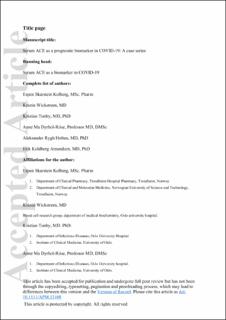| dc.contributor.author | Kolberg, Espen Skarstein | |
| dc.contributor.author | Tonby, Kristian | |
| dc.contributor.author | Wickstrøm, Kristin | |
| dc.contributor.author | Riise, Anne Margarita Dyrhol | |
| dc.contributor.author | Holten, Aleksander Rygh | |
| dc.contributor.author | Amundsen, Erik Koldberg | |
| dc.date.accessioned | 2021-01-04T14:31:27Z | |
| dc.date.available | 2021-01-04T14:31:27Z | |
| dc.date.created | 2020-12-30T14:10:36Z | |
| dc.date.issued | 2020 | |
| dc.identifier.issn | 0903-4641 | |
| dc.identifier.uri | https://hdl.handle.net/11250/2721321 | |
| dc.description.abstract | We have earlier proposed that serum ACE (s‐ACE) could be used as a biomarker for severity in COVID‐19 due to an assumed inverse relationship between ACE and ACE2. High s‐ACE could indicate lower ACE2 activity and therefore more widespread and severe SARS‐CoV2 infection, owing to virally mediated downregulation of ACE2 (1). Dysregulation of the Renin‐Angiotensin‐Aldosterone system (RAAS) are found in comorbidities known as risk factors for increased morbidity and mortality, such as hypertension and cardiovascular disease (2). | en_US |
| dc.language.iso | eng | en_US |
| dc.publisher | Wiley Online Library | en_US |
| dc.title | Serum ACE as a prognostic biomarker in COVID-19: A Case series | en_US |
| dc.type | Peer reviewed | en_US |
| dc.type | Journal article | en_US |
| dc.description.version | acceptedVersion | en_US |
| dc.source.journal | Acta Pathologica, Microbiologica et Immunologica Scandinavica (APMIS) | en_US |
| dc.identifier.doi | 10.1111/apm.13108 | |
| dc.identifier.cristin | 1864100 | |
| dc.description.localcode | First published: 23 December 2020.This article has been accepted for publication and undergone full peer review but has not been through the copyediting, typesetting, pagination and proofreading process, which may lead to differences between this version and the Version of Record. Please cite this article as doi:10.1111/apm.13108 | en_US |
| cristin.ispublished | true | |
| cristin.fulltext | postprint | |
| cristin.qualitycode | 1 | |
